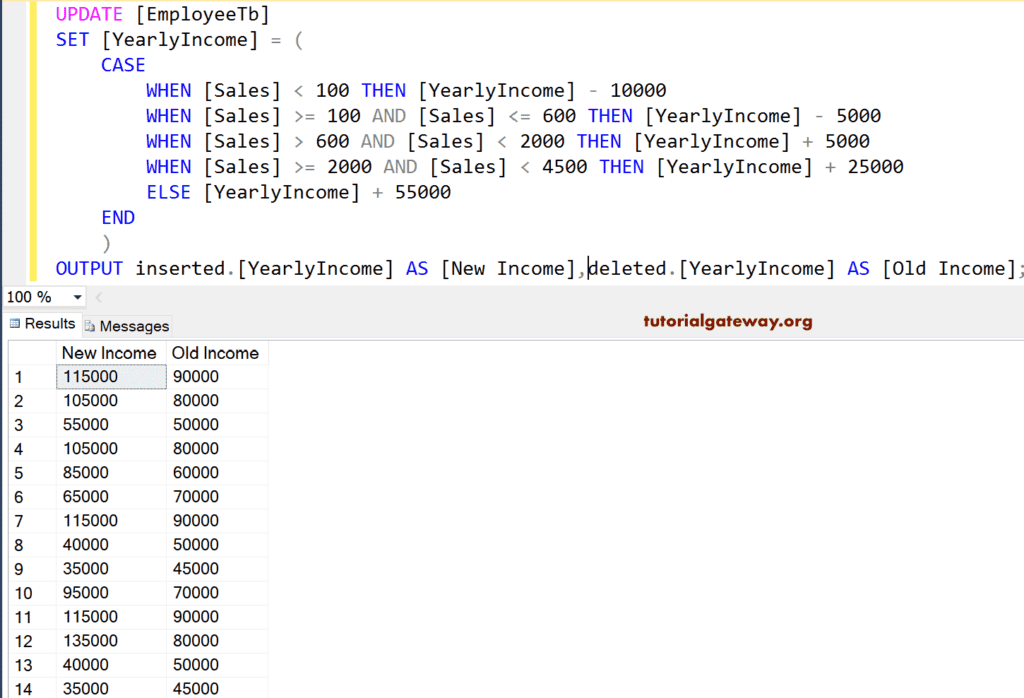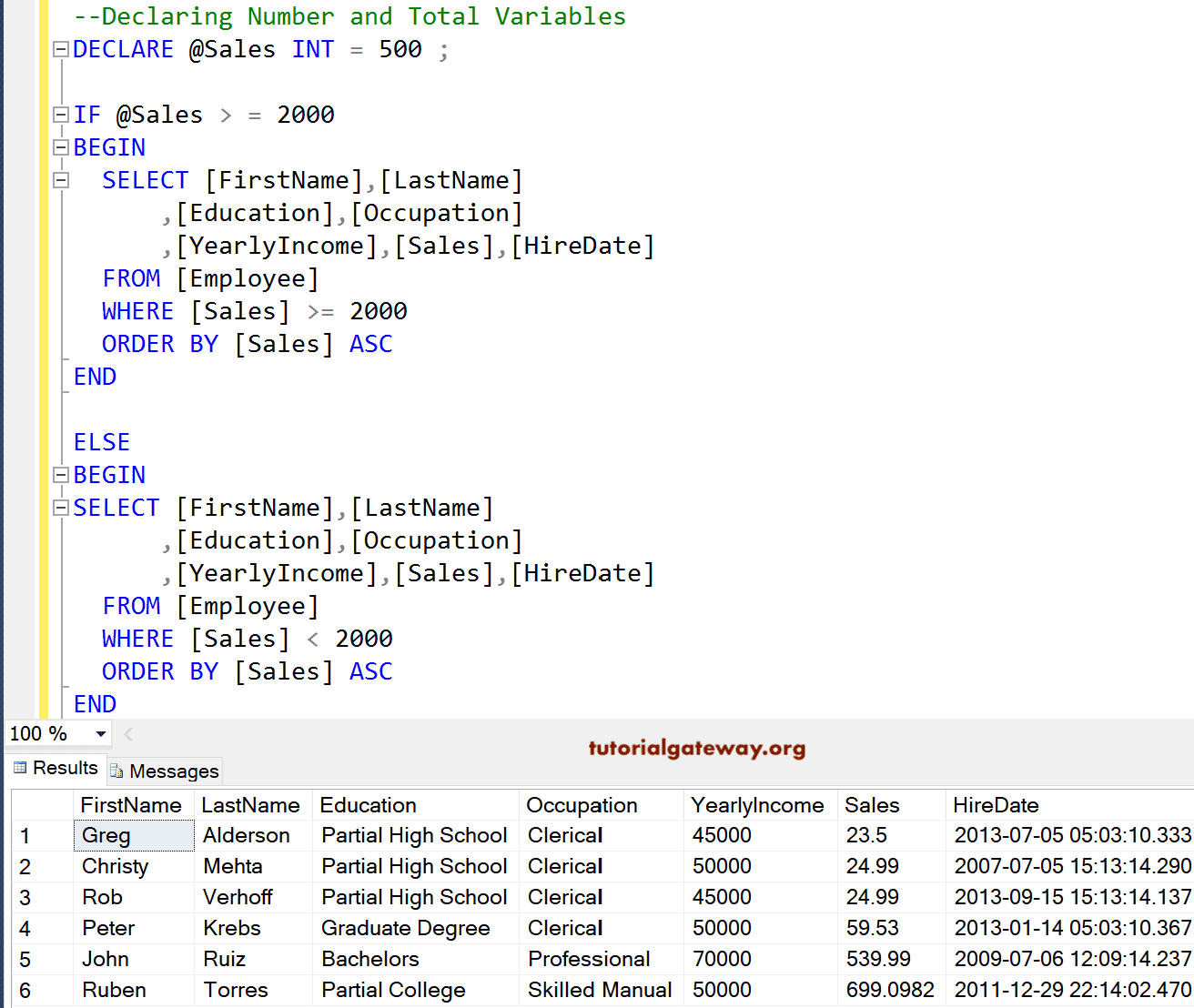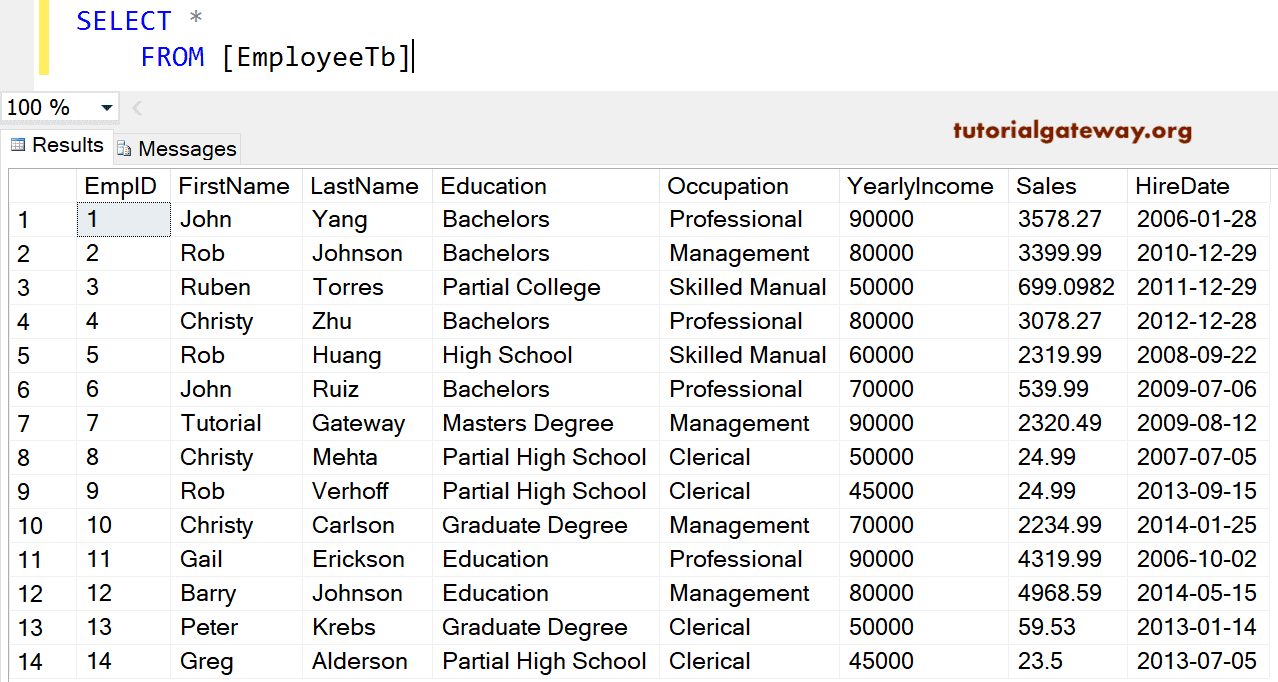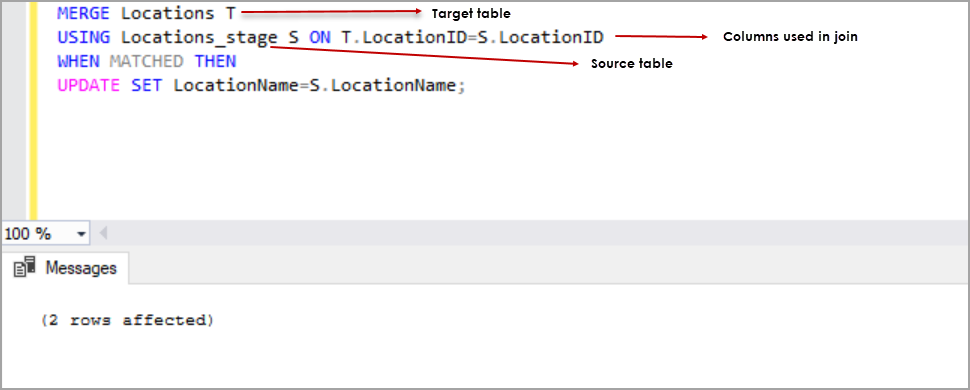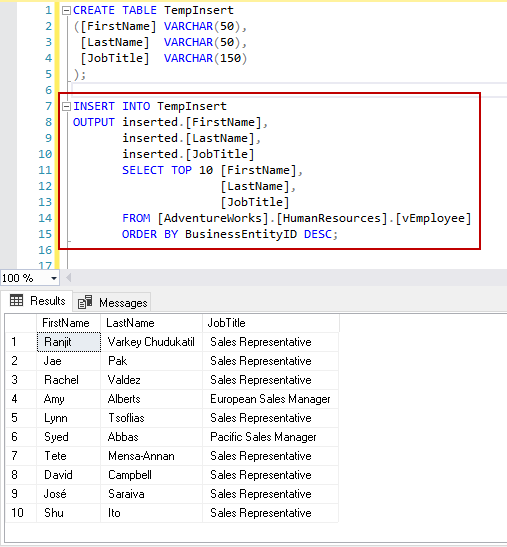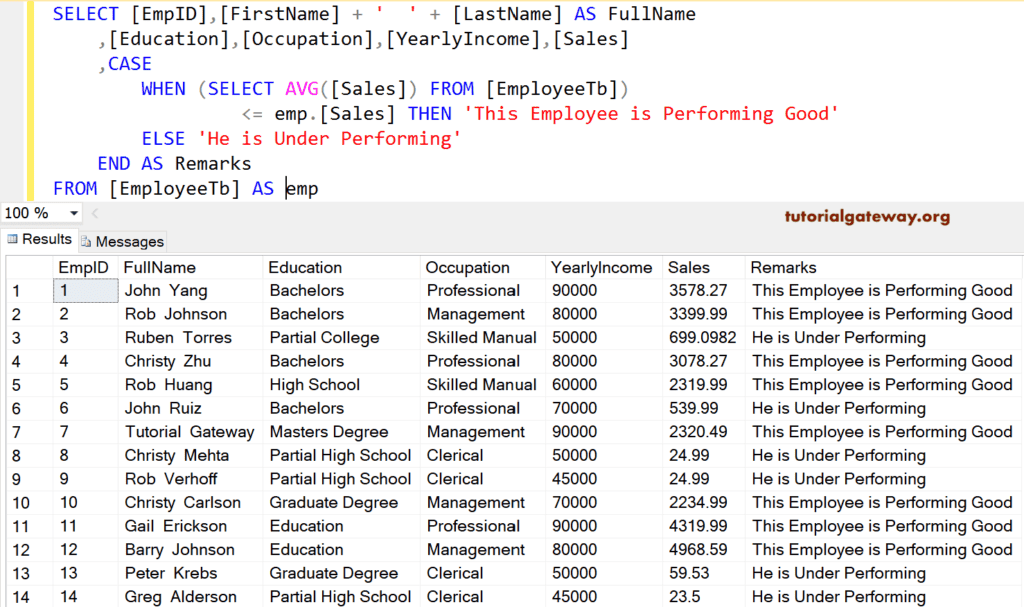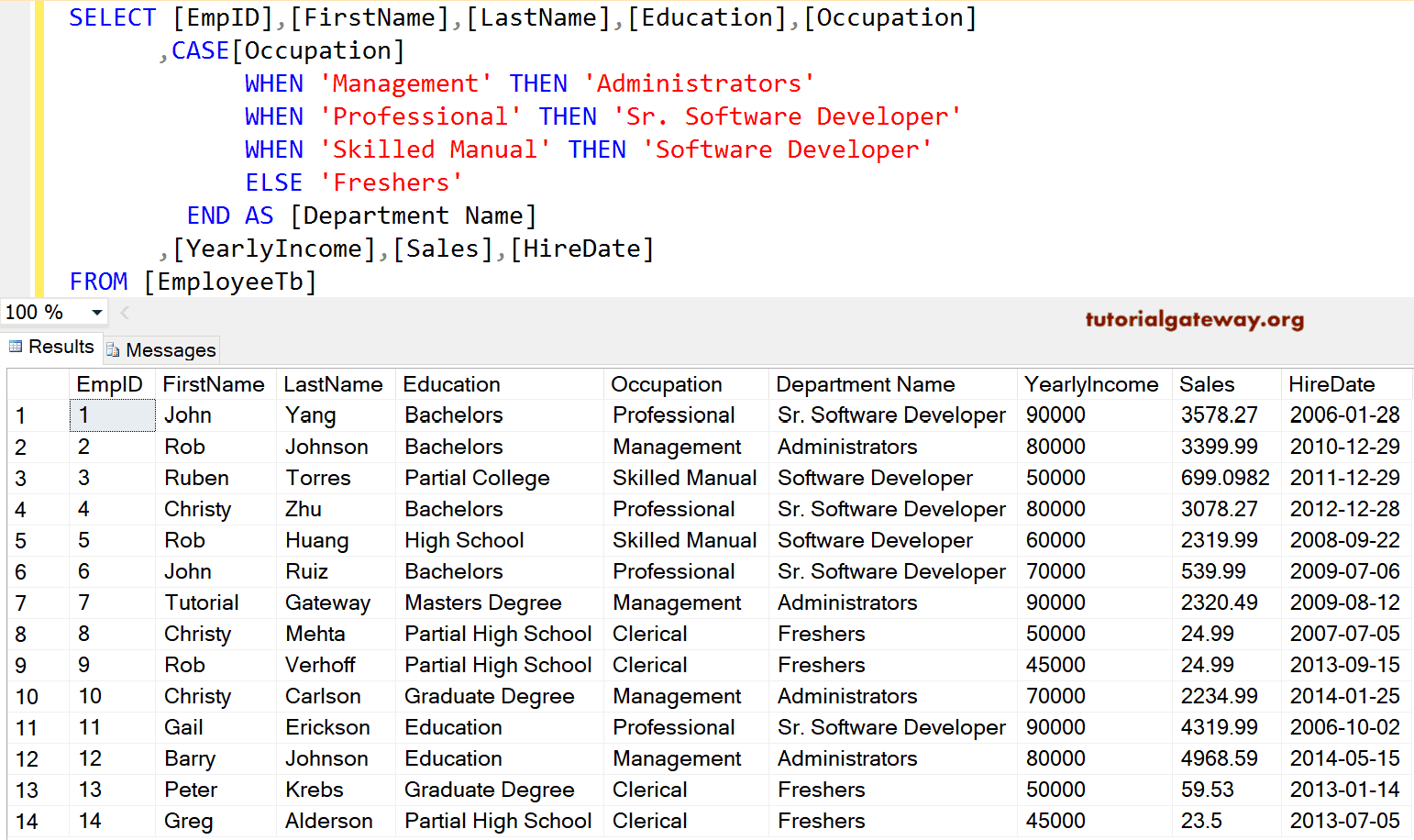Though both are used to exclude rows from the result set, you should use the WHERE clause to filter rows before grouping and use the HAVING clause to filter rows after grouping. In other words, WHERE can be used to filter on table columns while HAVING can be used to filter on aggregate functions like count, sum, avg, min, and max. There are times when you want to have SQL Server return an aggregated result set, instead of a detailed result set.
SQL Server has the GROUP BY clause that provides you a way to aggregate your SQL Server data. The GROUP BY clause allows you to group data on a single column, multiple columns, or even expressions. In this article I will be discussing how to use the GROUP by clause to summarize your data. Once the rows are divided into groups, the aggregate functions are applied in order to return just one value per group. It is better to identify each summary row by including the GROUP BY clause in the query resulst. All columns other than those listed in the GROUP BY clause must have an aggregate function applied to them.
ROLLUP is an extension of the GROUP BY clause that creates a group for each of the column expressions. Additionally, it "rolls up" those results in subtotals followed by a grand total. Under the hood, the ROLLUP function moves from right to left decreasing the number of column expressions that it creates groups and aggregations on. Since the column order affects the ROLLUP output, it can also affect the number of rows returned in the result set. You cannot test them as NULL values in join conditions or the WHERE clause to determine which rows to select. For example, you cannot add WHERE product IS NULL to the query to eliminate from the output all but the super-aggregate rows.
The GROUP BY clause is often used in SQL statements which retrieve numerical data. It is commonly used with SQL functions like COUNT, SUM, AVG, MAX and MIN and is used mainly to aggregate data. Data aggregation allows values from multiple rows to be grouped together to form a single row.
The first table shows the marks scored by two students in a number of different subjects. The second table shows the average marks of each student. The Group by Clause in SQL Server is used to divide similar types of records or data as a group and then return. If we use group by clause in the query then we should use grouping/aggregate function such as count(), sum(), max(), min(), and avg() functions.
The GROUP BY clause is a SQL command that is used to group rows that have the same values. Optionally it is used in conjunction with aggregate functions to produce summary reports from the database. You must use the aggregate functions such as COUNT(), MAX(), MIN(), SUM(), AVG(), etc., in the SELECT query. The result of the GROUP BY clause returns a single row for each value of the GROUP BY column. The Group by clause is often used to arrange identical duplicate data into groups with a select statement to group the result-set by one or more columns.
This clause works with the select specific list of items, and we can use HAVING, and ORDER BY clauses. Group by clause always works with an aggregate function like MAX, MIN, SUM, AVG, COUNT. In the result set, the order of columns is the same as the order of their specification by the select expressions. If a select expression returns multiple columns, they are ordered the same way they were ordered in the source relation or row type expression. The above query includes the GROUP BY DeptId clause, so you can include only DeptId in the SELECT clause.
What Is Group By Clause In Sql Server You need to use aggregate functions to include other columns in the SELECT clause, so COUNT is included because we want to count the number of employees in the same DeptId. The SUM() function returns the total value of all non-null values in a specified column. Since this is a mathematical process, it cannot be used on string values such as the CHAR, VARCHAR, and NVARCHAR data types. When used with a GROUP BY clause, the SUM() function will return the total for each category in the specified table. Expression_n The expressions that are not encapsulated within an aggregate function and must be included in the GROUP BY clause. Aggregate_function It can be a function such as SUM, COUNT, MIN, MAX, or AVG functions.
Tables The tables that you wish to retrieve records from. There must be at least one table listed in the FROM clause. The conditions that must be met for the records to be selected. The GROUP BY clause arranges rows into groups and an aggregate function returns the summary (count, min, max, average, sum, etc.,) for each group.
Finally, following all other rows, an extra super-aggregate summary row appears showing the grand total for all years, countries, and products. This row has the year, country, and products columns set to NULL. There is no doubt that SQL is an essential skill and every programmer, developer, DevOps, and Business analyst should know SQL. If you want to learn SQL from scratch then you have come to the right place.
THE GROUP BY clause in SQL is another important command to master for any programmer. FILTER is a modifier used on an aggregate function to limit the values used in an aggregation. All the columns in the select statement that aren't aggregated should be specified in a GROUP BY clause in the query. As we can see clearly the STRING_AGG function sorted the concatenated expressions in the ascending order according to row values of the FirstName column.
We need to underline one point about this type of usages. The GROUP BY clause will be necessary if the STRING_AGG result is not a sole column in the result set of the query. Like most things in SQL/T-SQL, you can always pull your data from multiple tables.
Performing this task while including a GROUP BY clause is no different than any other SELECT statement with a GROUP BY clause. The fact that you're pulling the data from two or more tables has no bearing on how this works. In the sample below, we will be working in the AdventureWorks2014 once again as we join the "Person.Address" table with the "Person.BusinessEntityAddress" table.
I have also restricted the sample code to return only the top 10 results for clarity sake in the result set. Following each set of rows for a given year, an extra super-aggregate summary row appears showing the total for all countries and products. These rows have the country and productscolumns set to NULL. The GROUP BY clause divides the rows returned from the SELECTstatement into groups. For each group, you can apply an aggregate function e.g.,SUM() to calculate the sum of items or COUNT()to get the number of items in the groups. Here, you can add the aggregate functions before the column names, and also a HAVING clause at the end of the statement to mention a condition.
This statement is used to group records having the same values. The GROUP BY statement is often used with the aggregate functions to group the results by one or more columns. Use theSQL GROUP BYClause is to consolidate like values into a single row.
The group by returns a single row from one or more within the query having the same column values. Its main purpose is this work alongside functions, such as SUM or COUNT, and provide a means to summarize values. When you start learning SQL, you quickly come across the GROUP BY clause. Data grouping—or data aggregation—is an important concept in the world of databases.
In this article, we'll demonstrate how you can use the GROUP BY clause in practice. We've gathered five GROUP BY examples, from easier to more complex ones so you can see data grouping in a real-life scenario. As a bonus, you'll also learn a bit about aggregate functions and the HAVING clause. Contrary to what most books and classes teach you, there are actually 9 aggregate functions, all of which can be used with a GROUP BY clause in your code. As we have seen in the samples above, you can have a GROUP BY clause without an aggregate function as well.
As we demonstrated earlier in this article, the GROUP BY clause can group string values also, so it doesn't always have to be a numeric or date value. Adding a HAVING clause after your GROUP BY clause requires that you include any special conditions in both clauses. If the SELECT statement contains an expression, then it follows suit that the GROUP BY and HAVING clauses must contain matching expressions. It is similar in nature to the "GROUP BY with an EXCEPTION" sample from above. In the next sample code block, we are now referencing the "Sales.SalesOrderHeader" table to return the total from the "TotalDue" column, but only for a particular year. As you can see in the result set above, the query has returned all groups with unique values of , , and .
The NULL NULL result set on line 11 represents the total rollup of all the cubed roll up values, much like it did in the GROUP BY ROLLUP section from above. Another extension, or sub-clause, of the GROUP BY clause is the CUBE. The CUBE generates multiple grouping sets on your specified columns and aggregates them. In short, it creates unique groups for all possible combinations of the columns you specify. For example, if you use GROUP BY CUBE on of your table, SQL returns groups for all unique values , , and . IIt is important to note that using a GROUP BY clause is ineffective if there are no duplicates in the column you are grouping by.
A better example would be to group by the "Title" column of that table. The SELECT clause below will return the six unique title types as well as a count of how many times each one is found in the table within the "Title" column. The SELECT statement used in the GROUP BY clause can only be used contain column names, aggregate functions, constants and expressions. Following each set of product rows for a given year and country, an extra super-aggregate summary row appears showing the total for all products. The GROUP BY clause permits a WITH ROLLUP modifier that causes summary output to include extra rows that represent higher-level (that is, super-aggregate) summary operations. ROLLUPthus enables you to answer questions at multiple levels of analysis with a single query.
For example, ROLLUP can be used to provide support for OLAP operations. In this lesson you learned to use the SQL GROUP BY and aggregate functions to increase the power expressivity of the SQL SELECT statement. You know about the collapse issue, and understand you cannot reference individual records once the GROUP BY clause is used. When a query has a GROUP BY, rather than returning every row that meets the filter condition, values are first grouped together. The rows returned are the unique combinations within the columns. In this lesson, we will learn uses of the GROUP BY clause in SQL.
GROUP BY is often used together with SQL aggregate functions like COUNT, SUM, AVG, MAX and MIN that act on numeric data. Together with these functions, the GROUP BY clause enhances the power of SQL and facilitates the creation of reports with summary data. An aggregate function performs a calculation on a group and returns a unique value per group. For example, COUNT() returns the number of rows in each group. Other commonly used aggregate functions are SUM(), AVG() , MIN() , MAX() .
The GROUP BY statement is often used with aggregate functions (COUNT(),MAX(),MIN(), SUM(),AVG()) to group the result-set by one or more columns. This syntax allows users to perform analysis that requires aggregation on multiple sets of columns in a single query. Complex grouping operations do not support grouping on expressions composed of input columns. A GROUP BY statement in SQL specifies that a SQL SELECT statement partitions result rows into groups, based on their values in one or several columns.
Typically, grouping is used to apply some sort of aggregate function for each group. Also, when we use aggregate functions, we need to add any non-aggregate columns into the GROUP BY. Otherwise, we'll get an error. JOINS are SQL statements used to combine rows from two or more tables, based on a related column between those tables.
We can use the SQL GROUP BY statement to group the result set based on a column/ columns. This is your most expensive department in terms of salary. In my code here I first created and populated a table named NullGroupBy. The first and last rows have a value of NULL from the OrderDate, and the other two columns have different OrderDate values.
As you can see by reviewing the output above, SQL Server rolls-up the two rows that contain a NULL OrderDate into a single summarized row. In my example above, my GROUP BY clause controlled what column was used to aggregate the AdventureWorks2012.Sales.SalesOrderDetail data. In my example I summarize the data based on the CarrierTrackingNumber.
When you group your data the only columns that are valid in the selection list are columns that can be aggregated, plus columns used on the GROUP BY clause. In my example I aggregated the LineTotal amount using the SUM function. For the aggregated value I set a column alias of SummarizedLineTotal. You can use SQL GROUP BY to divide rows in results into groups with an aggregate function.
It sounds easy to sum, average, or count records with it. Though it's not required by SQL, it is advisable to include all non-aggregated columns from your SELECT clause in your GROUP BY clause. GROUP BY enables you to use aggregate functions on groups of data returned from a query. The SUM function is used to sum values of a given field.
For example, the following simple SQL statement sums the values of the DailyAllowance field for all records in the Survey table. Here, the GROUP BY clause is not needed as this SQL statement does not select any other field except the value returned by the SUM function. Note – There is a restriction regarding the use of columns in the GROUP BY clause.
Each column appearing in the SELECT list of the query must also appear in the GROUP BY clause. This restriction does not apply to constants and to columns that are part of an aggregate function. (Aggregate functions are explained in the next subsection.) This makes sense, because only columns in the GROUP BY clause are guaranteed to have a single value for each group. Only the GROUP BY columns can be included in the SELECT clause. To use other columns in the SELECT clause, use the aggregate functions with them. The GROUP BY clause is used to get the summary data based on one or more groups.










